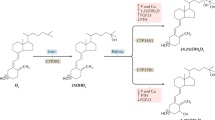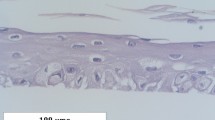Abstract
FIFTY years after the discovery that vitamin A controls cel differentiation in epithelial tissues the mechanism involved is still unknown. The recent introduction of two-cell and organ culture systems, involving serum-free medium, for the assay of vitamin A activity in vitro may help. One assay uses epidermal cell cultures derived from mouse skin1 and the other uses tracheal organ cultures from vitamin A-deficient hamsters2. In both, the observed cellular response depends on the addition of vitamin A, which induces a marked increase in the cellular RNA of the skin cultures and a change from the production of keratin to the production of cilia and mucus in the tracheal organ cultures. We have now investigated the Biological activity of seven analogues of natural vitamin A ester (β-retinyl acetate) and vitamin A acid (β-retinoic acid), in line with the common practice of assaying physiological and pharmacological actions of vitamins, hormones and drugs using structural analogues of a parent compound. In the analogues we used, the 5,6-cyclohexenyl ring system of natural vitamin A is modified substantially. Although data obtained in vivo show that modification of the ring portion of the molecule can reduce growth-promoting activity3–5, we found that several vitamin A analogues with alterations in the ring, including a shift of the 5,6-double bond of the cyclohexene ring to the 4,5-position and replacement of the cyclohexene ring with substituted aromatic and cyclopentene rings, have substantial activity in the skin and tracheobronchial assays. Because of the sensitivity of the two assays it is now possible to assay vitamin A activity in the 10−9–10−10M range (30–300 pg ml−1). Moreover, there is excellent correlation between the results of the two assays in terms of the evaluation of Biol.ogical activity of new analogues.
This is a preview of subscription content, access via your institution
Access options
Subscribe to this journal
Receive 51 print issues and online access
$199.00 per year
only $3.90 per issue
Buy this article
- Purchase on SpringerLink
- Instant access to full article PDF
Prices may be subject to local taxes which are calculated during checkout
Similar content being viewed by others
References
Sporn, M. B., Dunlop, N. M., and Yuspa, S. H., Science, 182, 722–723 (1973).
Clamon, G. H., Sporn, M. B., Smith, J. M., and Saffiotti, U., Nature, 250, 64–66 (1974).
Ames, S. R., Swanson, W. J., and Harris, P. L., J. Am. chem. Soc., 77, 4136–4138 (1955).
Pitt, G. A. J., Proc. Nutr. Soc., 24, 153–159 (1965).
Pitt, G. A. J., Am. J. Clin. Nutr., 22, 1045–1046 (1969).
Parker, R. C., Castor, L. N., and McCulloch, E. A., Spec. Publ. N. Y. Acad. Sci., 5, 303–313 (1957).
Lasnitzki, I., and Goodman, D. S., Cancer Res., 34, 1564–1571 (1974).
Bollag, W., Experientia, 30, 1198–1200 (1974).
Kaufman, D. G., Baker, M. S., Smith, J. M., Henderson, W. R., Harris, C. C., Sporn, M. B., and Saffiotti, U., Science, 111, 1105–1108 (1972).
Johnson, B. C., Kennedy, M., and Chiba, N., Am. J. Clin. Nutr., 22, 1048–1058 (1969).
Zile, M., and De Luca, H. F., Archs Biochem. Biophys., 140, 210–214 (1970).
De Luca, L., Kleinman, H. K., Little, E. P., and Wolf, G., Archs Biochem. Biophys., 145, 332–337 (1971).
Howell, J. M., Thompson, J. N., and Pitt, G. A. J., J. Reprod. Fert., 5, 159–167 (1963).
Thompson, J. N., Howell, J. M., and Pitt, G. A. J., Proc. R. Soc., B 159, 510–535 (1964).
Goodman, D. S., Smith, J. E., Hembry, R. M., and Dingle, J., J. Lipid Res., 15, 406–414 (1974).
Author information
Authors and Affiliations
Rights and permissions
About this article
Cite this article
SPORN, M., CLAMON, G., DUNLOP, N. et al. Activity of vitamin A analogues in cell cultures of mouse epidermis and organ cultures of hamster trachea. Nature 253, 47–50 (1975). https://doi.org/10.1038/253047a0
Received:
Revised:
Issue Date:
DOI: https://doi.org/10.1038/253047a0
This article is cited by
-
Nyctalopia and conjunctival xerosis indicating vitamin a deficiency in Cystic Fibrosis
Eye (1989)
-
Retinoic acid affects the cell cycle and increases total protein content in epithelial cells
Kidney International (1989)
-
Human epidermis reconstructed in vitro: A model to study keratinocyte differentiation and its modulation by retinoic acid
In Vitro Cellular & Developmental Biology (1989)
-
Regulation of growth and differentiation by vitamin a in a cloned fetal lung epithelial cell line cultured on collagen gell in hormone-supplemented medium
In Vitro Cellular & Developmental Biology (1988)
Comments
By submitting a comment you agree to abide by our Terms and Community Guidelines. If you find something abusive or that does not comply with our terms or guidelines please flag it as inappropriate.



